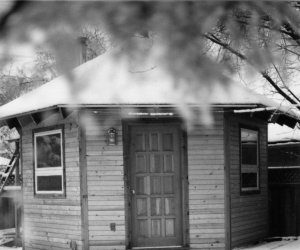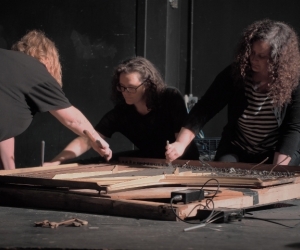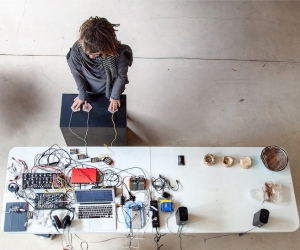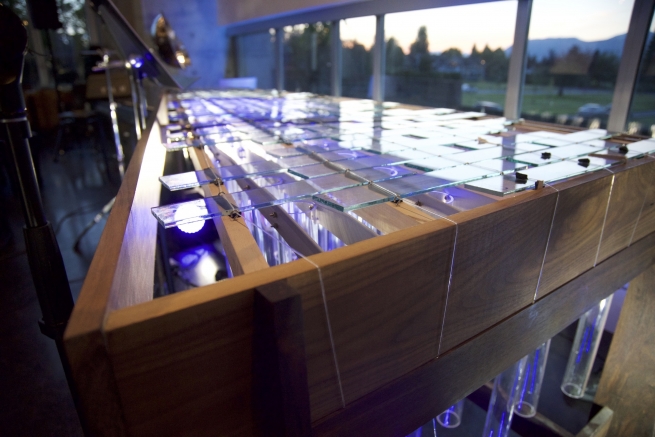
Arkora, a Toronto-based electric, vocal, chamber consort, includes an eight-voice choir and an accompanying ensemble, with irresistible composer bait—the Lumiphone.
A giant, three-octave, thirty-one-tone, equal-tempered (31-TET) glass marimba, the Lumiphone was designed and constructed by Benton Roark, who cofounded Arkora with Kathleen Allan in Vancouver in 2012. The choir sings in 31-TET harmonies; the electric guitar is fretless, in coordination with the violin and cello; and the 31-TET percussion keyboard rounds out the ensemble. Arkora’s last full-ensemble concert program, Transfigured Light, presented in 2018, showed off seven new commissions, including one of mine.
With Arkora’s planned Summer 2020 tour of Transfigured Light scuttled by COVID-19 cancellations, Roark, now based in Toronto, contacted me this spring to propose a new collaborative project, tentatively entitled Cloud Chamber, featuring four composer-performers: Roark, with various guitars and keyboards at his disposal, me (voice and viola), and Arkora’s Brandon Randall-Myers (electric guitars and variants) and Dan Morphy (percussion). Each would create a compositional structure to which the other three would add successive layers of recorded sound.

The process is new to all of us. We must work out the details as our creations unfold. In the late spring, the four of us convened an online meeting to elucidate how we will work together and to hash out how these vastly altered conditions are affecting our creative process.
The following conversation has been condensed and edited.
Tova Kardonne (left): What are your starting points for these creations?
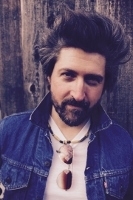
Benton Roark (right): I’m breaking some ground, writing text, unblocking some things by journaling. I had a nerve issue before the pandemic and I was advised to journal, so I gave it a shot and it felt good. What I have already brewing [is] probably along the lines of text.
TK: An assumption I made, looking at the structure you proposed, was that the originator would be framing the duration of the compositions. But maybe our layers can build transitions by layering durations and not necessarily respecting the frame. There should still be limits—so I wouldn’t, say, make your piece into an interlude in my piece—but maybe we can play with that assumption, that the composer decides on the frame.

Dan Morphy (left): I’m trying not to write a piece about isolation, but that’s what I’m in. I’m thinking about the nature of isolation, the rituals that form, the science of those activities, how they take up time. Unless one of you [tells] me that we need to obscure what’s happening in our world, I know that this piece will be about this time.
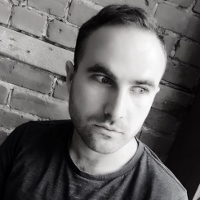
Brendon Randall-Myers (right): I’ve written in a lot of different ways, and I kind of want to see where we overlap . . . The process that Benton proposed describes passing around a piece once around a loop, and it occurs to me that I might want it to go around more than once. I’d be interested in working with stems, where you can separate out layers that the others have added.
BR: We talk about bubbles a lot these days, and here we are making a quartet that’s its own bubble. But it does make sense to try to be permeable to everything, in terms of energy, and not seal ourselves off. Let’s just see how our openness to the world gets channelled.
TK: What makes you most excited or most uncomfortable about working this way?
DM: I hate composing transitions!
I used to paint canvases when I was camping with my best friend. We’d spend time going back and forth with a single idea. Sometimes you don’t even know what you’ve painted, you don’t even know what’s there until you see a gesture created by somebody else. When we started talking about this project I immediately went into that mindset, and that’s really invigorating.
BR: I tried to propose a structure that leaves it as open as possible, but if I had assumptions, going into this, I assumed that we would be okay if we messed with each other’s ideas. I assumed that; but I shouldn’t assume that. If someone is really attached to something, that’s great; but we must be transparent about that.
TK: In handing off a creation, I feel a great deal of trust in each of your artistic instincts, and that trust comes from knowing I could say which part of the sound constitutes the identity of the piece. My hope is to transmit that faithfully, and then let go. There’s discomfort in handing it off and trusting that you’ll partake of that same idea with me, but that’s an exciting risk.
BR-M: I’m super similar in that regard. Part of me finds it liberating to transmit the [piece] to the best of my ability and then see what someone else will do with it. Benton, the structure you proposed—that someone originates the material and then it comes back to them to do the final assembly—that structure appealed to me: you give out the seeds of something, people do whatever with it, but then the creator of the seed retains some control.
BR: And sometimes you don’t even know how to interpret your own line of access to the source of your idea. You can interpret it and translate it, but you might not know if you got the translation right until someone else hears it their way. And it can get more obscure or even more revealed, as a possibility of hearing it together. That’s the collaborative dream in this.
Luminphone photo by Brian Cyr.
